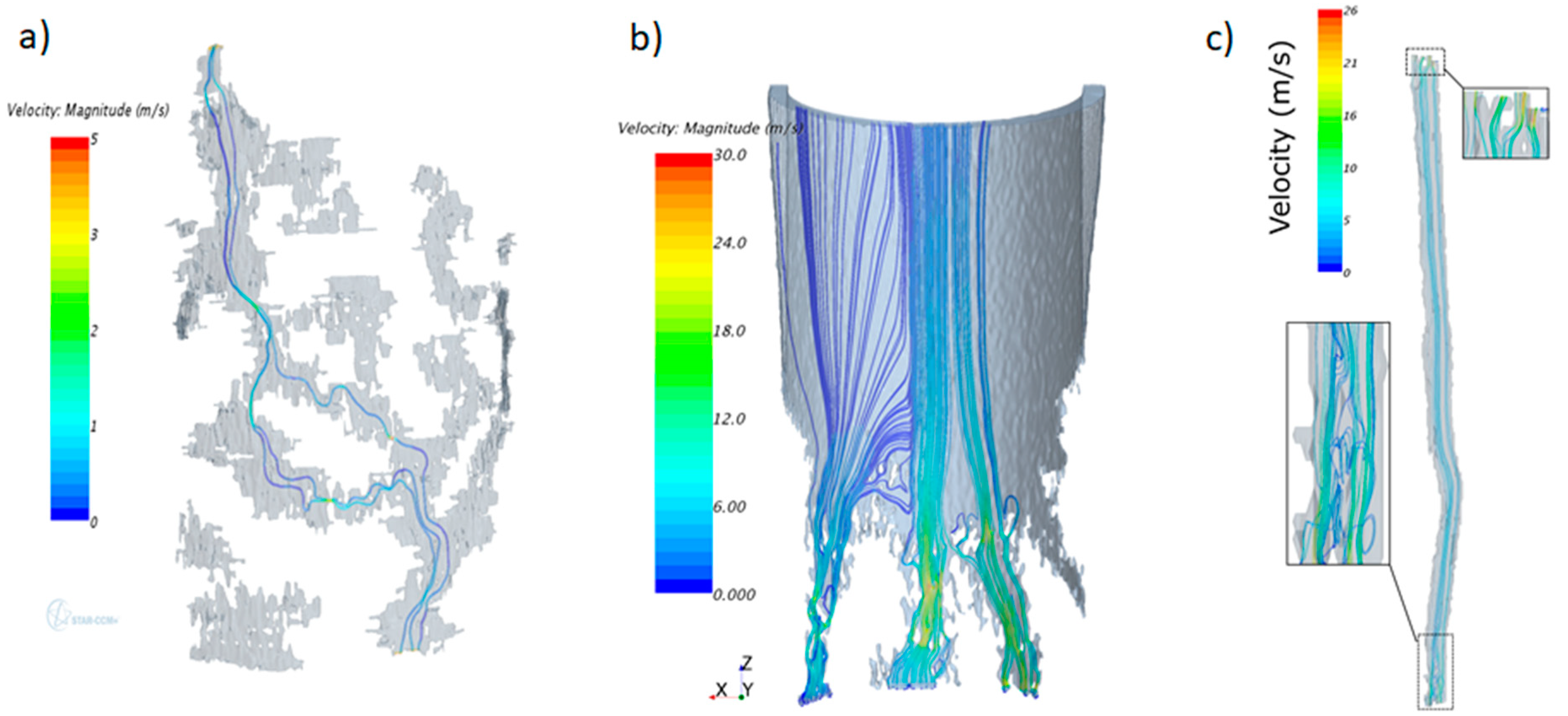Digital Cement Integrity: A Methodology for 3D Visualization of Cracks and Microannuli in Well Cement
Abstract
1. Introduction
2. Experimental Methodology
2.1. Sample Preparation
2.2. CT Scanning Procedure
2.3. Post Processing of CT Images
2.4. Simulation of Fluid Flow
2.5. Limitations of Experimental Procedure
3. Results and Discussion
3.1. Visualization of Radial Cracks and Internal Defects in Cement Sheaths
3.2. Visualization of Microannuli and Cement Debonding
3.3. Visualization of Fluid Flow through Cracks and Microannuli
4. Conclusions
- Radial cracks do usually not form in symmetrical and predictable patterns. Only one crack is formed first, and subsequent cracks may form later. The cement cracks may propagate into the surrounding rock.
- Microannuli do not have uniform geometries with homogeneous aperture around the circumference. Real microannuli geometries can be somewhat random and may depend upon how they are generated.
- Fluid flow through cracks and microannuli do not follow Darcian linearity, due to local heterogeneities and complex flow patterns.
Author Contributions
Funding
Acknowledgments
Conflicts of Interest
References
- Bourgoyne, A.T.; Scott, S.L.; Regg, J.B. Sustained Casing Pressure in Offshore Producing Wells (OTC-11029). In Proceedings of the Offshore Technology Conference, Houston, TX, USA, 3–6 May 1999. [Google Scholar]
- Vignes, B.; Aadnoy, B. Well Integrity Issues Offshore Norway. SPE Prod. Oper. 2010, 25, SPE-112535-PA. [Google Scholar] [CrossRef]
- Watson, T.L.; Bachu, S. Evaluation of the potential for gas and CO2 leakage along wellbores. SPE Drill. Complet. 2009, 1, SPE-106817-PA. [Google Scholar] [CrossRef]
- Trudel, E.; Bizhani, M.; Zare, M.; Frigaard, I. Plug and abandonment practices and trends: A British Colombia perspective. J. Pet. Sci. Eng. 2019, 183, 106417. [Google Scholar] [CrossRef]
- Gasda, S.E.; Bachu, S.; Celia, M.A. Spatial characterization of the location of potentially leaky wells penetrating a deep saline aquifer in a mature sedimentary basin. Environ. Geol. 2004, 46, 707–720. [Google Scholar] [CrossRef]
- Zhang, M.; Bachu, S. Review of integrity of existing wells in relation to CO2 geological storage: What do we know? Int. J. Greenh. Gas Control 2011, 5, 826–840. [Google Scholar] [CrossRef]
- Carrol, S.; Carey, J.W.; Dzombak, D.; Huerta, N.J.; Li, L.; Richard, T.; Um, W.; Walsh, S.D.C.; Zhang, L. Review: Role of chemistry, mechanics, and transport on well integrity in CO2 storage environments. Int. J. Greenh. Gas Control 2016, 49, 149–160. [Google Scholar] [CrossRef]
- Kiran, R.; Teodoriu, C.; Dadmohammadi, Y.; Nygaard, R.; Wood, D.; Mokhtari, M.; Salehi, S. Identification and evaluation of well integrity and causes of failure of well integrity barriers (A review). J. Nat. Gas. Sci. Eng. 2017, 45, 511–526. [Google Scholar] [CrossRef]
- Vrålstad, T.; Saasen, A.; Fjær, E.; Øia, T.; Ytrehus, J.D.; Khalifeh, M. Plug & abandonment of offshore wells: Ensuring long-term well integrity and cost efficiency. J. Pet. Sci. Eng. 2019, 173, 478–491. [Google Scholar]
- Thiercelin, M.J.; Dargaud, B.; Baret, J.F.; Rodriquez, W.J. Cement Design Based on Cement Mechanical Response. SPE Drill. Complet. 1998, 13, SPE-52890-PA. [Google Scholar] [CrossRef]
- Bosma, B.; Ravi, K.; van Driel, W.; Schreppers, G.J. Design Approach to Sealant Selection for the Life of the Well (SPE 56536). In Proceedings of the 1999 SPE Annual Technical Conference and Exhibition, Houston, TX, USA, 3–6 October 1999. [Google Scholar]
- Ravi, K.; Bosma, M.; Gastebled, O. Improve the Economics of Oil and Gas Wells by Reducing the Risk of Cement Failure (IADC/SPE 74497-MS). In Proceedings of the IADC/SPE Drilling Conference, Dallas, TX, USA, 26–28 February 2002. [Google Scholar]
- Bois, A.-P.; Garnier, A.; Rodot, F.; Sain-Marc, J.; Aimard, N. How to Prevent Loss of Zonal Isolation Through a Comprehensive Analysis of Micro-Annulus Formation. SPE Drill. Complet. 2011, 26, SPE-124719-PA. [Google Scholar] [CrossRef]
- Bois, A.-P.; Garnier, A.; Galdiolo, G.; Laudet, J.-B. Use of a Mechanistic Model to Forecast Cement-Sheath Integrity. SPE Drill. Complet. 2012, 27, SPE-139668-PA. [Google Scholar] [CrossRef]
- Therond, E.; Bois, A.-P.; Whaley, K.; Murillo, R. Large-Scale Testing and Modeling for Cement Zonal Isolation in Water-Injection Wells. SPE Drill. Complet. 2017, 32, SPE-181428-PA. [Google Scholar] [CrossRef]
- Nygaard, R.; Salehi, S.; Weideman, B.; Lavoie, R. Effect of Dynamic Loading on Wellbore Leage for the Wabamun Area CO2-Sequestration Project. J. Can. Pet. Technol. 2014, 53, SPE-146640-PA. [Google Scholar] [CrossRef]
- Carey, J.W.; Wigand, M.; Chipera, S.J.; WoldeGabriel, G.; Pawar, R.; Lichtner, P.C.; Wehner, S.C.; Raines, M.A.; Guthrie, G.D., Jr. Analysis and performance of oil well cement with 30 years of CO2 exposure from the SACROC Unit, West Texas, USA. Int. J. Greenh. Gas Control 2007, 1, 75–85. [Google Scholar] [CrossRef]
- Goodwin, K.J.; Crook, R.J. Cement Sheath Stress Failure (SPE 20453). In Proceedings of the 65th Annual Technical Conference and Exhibition, New Orleans, LA, USA, 23–26 September 1990. [Google Scholar]
- Jackson, P.B.; Murphey, C.E. Effect of Casing Pressure on Gas Flow through a Sheath of Set Cement (SPE 25698). In Proceedings of the SPE Drilling Conference, Amsterdam, The Netherlands, 23–25 February 1993. [Google Scholar]
- Boukhelifa, L.; Moroni, N.; James, S.G.; Le Roy-Delage, S.; Thiercelin, M.J.; Lemaire, G. Evaluation of Cement Systems for Oil and Gas Well Zonal Isolation in a Full-Scale Annular Geometry. SPE Drill. Complet. 2005, 20, SPE-87195-PA. [Google Scholar] [CrossRef]
- Kupresan, D.; Heathman, J.; Radonjic, M. Casing Expansion as a Promising Solution for Microannular Gas Migration. SPE Drill. Complet. 2014, 29, 366–371, SPE-168056-PA. [Google Scholar] [CrossRef]
- Shadravan, A.; Schubert, J.; Amani, M.; Teodoriu, C. Using Fatigue-Failure Envelope for Cement Sheath-Integrity Evaluation. SPE Drill. Complet. 2015, 30, 68–75, SPE-168321-PA. [Google Scholar] [CrossRef]
- Nagelhout, A.; Bosma, M.G.R.; Mul, P.; Krol, G.; van Velzen, H.; Joldersma, J.; James, S.G.; Dargaud, B.; Schreuder, R.; Théry, F. Laboratory and Field Validation of a Sealant System for Critical Plug-and-Abandon Applications. SPE Drill. Complet. 2010, 25, 314–321, SPE-97347-PA. [Google Scholar] [CrossRef]
- Stormont, J.C.; Garcia Fernandez, S.; Taha, M.R.; Matteo, E.N. Gas flow through cement-casing microannuli under varying stress conditions. Geomech. Energy Environ. 2018, 13, 1–13. [Google Scholar] [CrossRef]
- Garcia Fernandez, S.; Matteo, E.N.; Taha, M.R.; Stormont, J.C. Characterization of wellbore microannuli. J. Nat. Gas Sci. Eng. 2019, 62, 13–25. [Google Scholar] [CrossRef]
- Al Ramadan, M.; Salehi, S.; Kwatia, G.; Ezeakacha, C.; Teodoriu, C. Experimental investigation of well integrity: Annular gas migration in cement column. J. Pet. Sci. Eng. 2019, 179, 126–135. [Google Scholar] [CrossRef]
- Bois, A.-P.; Vu, M.-H.; Noël, K.; Badalamenti, A.; Delabroy, L.; Thérond, E.; Hansen, K. Evaluating Cement-Plug Mechanical and Hydraulic Integrity. SPE Drill. Complet. 2019, 34. SPE-191335-PA. [Google Scholar] [CrossRef]
- Kutchko, B.; Crandall, D.; Moore, J.; Gill, M.; Haljasmaa, I.; Spaulding, R.; Harbert, W.; Benge, G.; DeBruijn, G.; Shine, J.M. Assessment of Foamed Cement Used in Deep Offshore Wells (SPE-170298-MS). In Proceedings of the SPE Deepwater Drilling and Completions Conference, Galveston, TX, USA, 10–11 September 2014. [Google Scholar]
- Fahrman, B.P.; Huerta, N.J.; Crandall, D.; Moore, J.E. Visualizing Well System Breakdown: Experimental and Numerical Analyses (ARMA 17-867). In Proceedings of the 51st US Rock Mechanics/Geomechanics Symposium, San Francisco, CA, USA, 25–28 June 2017. [Google Scholar]
- Pang, X.; Maxson, J.K.; Jimenez, W.C.; Singh, J.P.; Morgan, R.G. Microscale Characterization of Field and Laboratory Foamed Cement by Use of X-Ray Microcomputed Tomography. SPE J. 2017, 22, SPE-180278-PA. [Google Scholar] [CrossRef]
- Dalton, L.E.; Brown, S.; Moore, J.; Crandall, D.; Gill, M. Laboratory Foamed-Cement-Curing Evolution Using CT Scanning: Insights from Elevated-Pressure Generation. SPE Drill. Complet. 2019, 34, SPE-194007-PA. [Google Scholar] [CrossRef]
- Yang, X.; Kuru, E.; Gingras, M.; Iremonger, S.; Taylor, J.; Lin, Z. Quantifying 2D and 3D Fracture Leakage Pathways Observed in Wellbore Cement after Uniaxial Compressive Loading (SPE-198683-MS). In Proceedings of the SPE Thermal Well Integrity and Design Symposium, Banff, AB, Canada, 19–21 November 2019. [Google Scholar]
- Jung, H.B.; Jansik, D.; Um, W. Imaging Wellbore Cement Degradation by Carbon Dioxide under Geologic Sequestration Conditions Using X-ray Computed Microtomography. Environ. Sci. Technol. 2013, 47, 283–289. [Google Scholar] [CrossRef]
- Jung, H.B.; Um, W. Experimental study of potential wellbore cement carbonation by various phases of carbon dioxide during geologic carbon sequestration. Appl. Geochem. 2013, 35, 161–172. [Google Scholar] [CrossRef]
- Jung, H.B.; Kabilan, S.; Carson, J.P.; Kuprat, A.P.; Um, W.; Martin, P.; Dahl, M.; Kafentziz, T.; Varga, T.; Stephens, S.; et al. Wellbore cement fracture evolution at the cement-basalt caprock interface during geologic carbon sequestration. Appl. Geochem. 2014, 47, 1–16. [Google Scholar] [CrossRef]
- Kabilan, S.; Jung, H.B.; Kuprat, A.P.; Beck, A.N.; Varga, T.; Fernandez, C.A.; Um, W. Numerical Simulation of Permeability Change in Wellbore Cement Fractures after Geomechanical Stress and Geochemical Reactions Using X-ray Computed Tomography Imaging. Environ. Sci. Technol. 2016, 50, 6180–6188. [Google Scholar] [CrossRef]
- Um, W.; Rod, K.A.; Jung, H.B.; Brown, C.F. Geochemical alteration of wellbore cement by CO2 or CO2 + H2S reaction during long-term carbon storage. Greenh. Gas. Sci. Technol. 2017, 7, 852–865. [Google Scholar] [CrossRef]
- Chavez Panduro, E.A.; Torsæter, M.; Gawel, K.; Bjørge, R.; Gibaud, A.; Yang, Y.; Bruns, S.; Zheng, Y.; Sørensen, H.O.; Breiby, D.W. In-Situ X-ray Tomography Study of Cement Exposed to CO2 Saturated Brine. Environ. Sci. Technol. 2017, 51, 9344–9351. [Google Scholar] [CrossRef]
- Chavez Panduro, E.A.; Torsæter, M.; Gawel, K.; Bjørge, R.; Gibaud, A.; Bonnin, A.; Schlepütz, C.H.; Breiby, D.W. Computed X-rayTomography Study of Carbonate Precipitation in Large Portland Cement Pores. Cryst. Growth Des. 2019, 19, 5850–5857. [Google Scholar] [CrossRef]
- Bjørge, R.; Gawel, K.; Chavez Panduro, E.A.; Torsæter, M. Carbonation of silica cement at high-temperature well conditions. Int. J. Greenh. Gas Control 2019, 82, 261–268. [Google Scholar] [CrossRef]
- De Andrade, J.; Sangesland, S.; Skorpa, R.; Todorovic, J.; Vrålstad, T. Experimental Laboratory Setup for Visualization and Quantification of Cement-Sheath Integrity. SPE Drill. Complet. 2016, 31, SPE-173871-PA. [Google Scholar] [CrossRef]
- Skorpa, R.; Øia, T.; Taghipour, A.; Vrålstad, T. Laboratory Set-up for Determination of Cement Sheath Integrity During Pressure Cycling (OMAE2018-78696). In Proceedings of the ASME 2018 37th International Conference on Ocean, Offshore and Arctic Engineering, Madrid, Spain, 17–22 June 2018. [Google Scholar]
- Albawi, A.; De Andrade, J.; Torsæter, M.; Opedal, N.; Stroisz, A.; Vrålstad, T. Experimental Set-Up for Testing Cement sheath Integrity in Arctic Wells (OTC 24587). In Proceedings of the OTC Arctic Technology Conference, Houston, TX, USA, 10–12 February 2014. [Google Scholar]
- De Andrade, J.; Torsæter, M.; Todorovic, J.; Opedal, N.; Stroisz, A.; Vrålstad, T. Influence of Casing Centralization on Cement Sheath Integrity During Thermal Cycling (IADC/SPE-168012-MS). In Proceedings of the IADC/SPE Drilling Conference and Exhibition, Dallas, TX, USA, 4–6 March 2014. [Google Scholar]
- Vrålstad, T.; Skorpa, R.; Opedal, N.; De Andrade, J. Effect of Thermal Cycling on Cement Sheath Integrity: Realistic Experimental Tests and Simulation of Resulting Leakages (SPE-178467-MS). In Proceedings of the SPE Thermal Well Integrity and Design Symposium, Banff, AB, Canada, 23–25 November 2015. [Google Scholar]
- Todorovic, J.; Gawel, K.; Lavrov, A.; Torsæter, M. Integrity of Downscaled Well Models Subject to Cooling (SPE-180052). In Proceedings of the 2016 SPE Bergen One Day Seminar, Bergen, Norway, 20 April 2016. [Google Scholar]
- Vrålstad, T.; Skorpa, R.; Werner, B. Experimental Studies on Cement Sheath Integrity During Pressure Cycling (SPE/IADC-194171-MS). In Proceedings of the SPE/IADC Drilling Conference and Exhibition, The Hague, The Netherlands, 5–7 March 2019. [Google Scholar]
- Skorpa, R.; Werner, B.; Vrålstad, T. Effect of Mud on Cement Sheath Integrity (SPE-195625-MS). In Proceedings of the SPE Norway One Day Seminar, Bergen, Norway, 14 May 2019. [Google Scholar]
- Skorpa, R.; Werner, B.; Vrålstad, T. Effect of Rock on Cement Sheath Integrity: Shale vs. Sandstone (OMAE2019-96738). In Proceedings of the ASME 2019 38th International Conference on Ocean, Offshore and Arctic Engineering, Glasgow, UK, 9–14 June 2019. [Google Scholar]
- Skorpa, R.; Vrålstad, T. Visualization of Fluid Flow Through Cracks and Microannuli in Cement Sheaths. SPE J. 2018, 23, SPE-180019-PA. [Google Scholar] [CrossRef]
- Corina, A.N.; Skorpa, R.; Sangesland, S.; Vrålstad, T. submitted.
- Skorpa, R.; Vrålstad, T. Leakages through radial cracks in cement sheaths: Effect of geometry, viscosity and aperture (OMAE2020-18496). In Proceedings of the ASME 2020 39th International Conference on Ocean, Offshore and Arctic Engineering, Fort Lauderdale, FL, USA, 28 June–3 July 2020. [Google Scholar]
- Opedal, N.; Torsæter, M.; Vrålstad, T.; Cerasi, P. Potential Leakage Paths along Cement Formation Interfaces in Wellbores; Implications for CO2 Storage. Energy Procedia 2014, 51, 56–64. [Google Scholar] [CrossRef]
- Opedal, N.; Todorovic, J.; Torsæter, M.; Vrålstad, T.; Mushtaq, W. Experimental Study on the Cement-Formation Bonding (SPE 168138-MS). In Proceedings of the SPE International Symposium and Exhibition on Formation Damage Control, Lafayette, LA, USA, 26–28 February 2014. [Google Scholar]
- Opedal, N.; Todorovic, J.; Torsæter, M.; Akervoll, I.; Jafarzade, G. Filter Cake Behavior during Leakage at the Cement-Rock Interface in Wellbores (ARMA-15-341). In Proceedings of the 49th U.S. Rock Mechanics/Geomechanics Symposium, San Francisco, CA, USA, 28 June–1 July 2015. [Google Scholar]
- Opedal, N.; Lavrov, A.; Todorovic, J.; Torsæter, M. The importance of shale caprock damage for well integrity. Int. J. Greenh. Gas Control 2018, 74, 182–190. [Google Scholar] [CrossRef]
- Vrålstad, T.; Todorovic, J.; Saasen, A.; Godøy, R. Long-Term Integrity of Well Cements at Downhole Conditions (SPE-180058-MS). In Proceedings of the SPE Bergen One Day Seminar, Bergen, Norway, 20 April 2016. [Google Scholar]
- Khalifeh, M.; Todorovic, J.; Vrålstad, T.; Saasen, A.; Hodne, H. Long-term durability of rock-based geopolymers aged at downhole conditions for oil well cementing operations. J. Sustain. Cem. Based Mater. 2017, 6, 217–230. [Google Scholar] [CrossRef]
- Skorpa, R.; Todorovic, J.; Torsæter, M. Porosity changes in mud-affected rock and cement upon reaction with CO2. Energy Procedia 2017, 114, 5266–5274. [Google Scholar] [CrossRef]
- Thermo Fisher Scientific. Avizo Software for Materials Research: Materials Characterization and Quality Control (Reprint). Available online: https://assets.thermofisher.com/TFS-Assets/MSD/brochures/brochure-avizo-software-materials-research.pdf.
- Siemens PLM Software. Star-CCM+ (Reprint). Available online: https://mdx.plm.automation.siemens.com/star-ccm-plus.
- Gheibi, S.; Sangesland, S.; Vrålstad, T. Numerical modeling of radial fracturing of cement sheath caused by pressure tests (OMAE2019-96319). In Proceedings of the ASME 2019 38th International Conference on Ocean, Offshore and Arctic Engineering, Glasgow, UK, 9–14 June 2019. [Google Scholar]
- TerHeege, J.H.; Orlic, B.; Hoedeman, G.C. Characteristics of mechanical wellbore failure and damage: Insights of discrete element modelling and application to CO2 storage (ARMA 15-174). In Proceedings of the 49th US Rock Mechanics/Geomechanics Symposium, San Francisco, CA, USA, 28 June–1 July 2015. [Google Scholar]
- Lavrov, A.; Todorovic, J.; Torsæter, M. Numerical study of tensile thermal stresses in a casing-cement-rock system with heterogeneities (ARMA 15-110). In Proceedings of the 49th US Rock Mechanics/Geomechanics Symposium, San Francisco, CA, USA, 28 June–1 July 2015. [Google Scholar]
- Roy, P.; Walsh, S.D.C.; Morris, J.P.; Iyer, J.; Hao, Y.; Carrol, S.; Gawel, K.; Todorovic, J.; Torsæter, M. Studying the Impact of Thermal Cycling on Wellbore Integrity during CO2 Injection. ARMA 16-0668. In Proceedings of the 50th US Rock Mechanics/Geomechanics Symposium, Houston, TX, USA, 26–29 June 2016. [Google Scholar]
- Orlic, B.; Chitu, A.; Brunner, L.; Koenen, M.; Wollenweber, J.; Schreppers, G.-J. Numerical investigations of cement interface debonding for assessing well integrity risks (ARMA 18-1298). In Proceedings of the 52nd US Rock Mechanics/Geomechanics Symposium, Seattle, WA, USA, 17–20 June 2018. [Google Scholar]
- Wise, J.; Cedola, A.; Nygaard, R.; Hareland, G.; Arild, Ø.; Lohne, H.P.; Ford, E.P. Wellbore Characteristics that Control Debonding Initiation and Microannuli Width in Finite Element Simulations. J. Pet. Sci. Eng. 2020, 191, 107157. [Google Scholar] [CrossRef]
- Aas, B.; Sørbø, J.; Stokka, S.; Saasen, A.; Godøy, R.; Lunde, Ø.; Vrålstad, T. Cement Placement with Tubing Left in Hole during Plug and Abandonment Operations (IADC/SPE-178840-MS). In Proceedings of the IADC/SPE Drilling Conference and Exhibition, Fort Worth, TX, USA, 1–3 March 2016. [Google Scholar]
- Corina, A.N.; Opedal, N.; Vrålstad, T.; Skorpa, R.; Sangesland, S. The Effect of Casing Pipe Roughness on Cement Plug Integrity. SPE Drill. Complet. 2020. SPE-194158-PA. [Google Scholar] [CrossRef]
- Skadsem, H.J.; Gardner, D.; Beltrán-Jiménez, K.; Kragset, S.; Delabroy, L.; Ruckert, F. Fluid Migration Characterization of Cemented Sections Retrieved from a North Sea Production Well (SPE/IADC-199663-MS). In Proceedings of the SPE/IADC Drilling Conference and Exhibition, Galveston, TX, USA, 3–5 March 2020. [Google Scholar]
- Ichim, A.C.; Teodoriu, C. Revisiting Thermal Well Integrity Through a Closer Look at Casing-Cement-Formation Interaction (SPE-182525-MS). In Proceedings of the SPE Thermal Well Integrity and Design Symposium, Banff, AB, Canada, 28 November–1 December 2016. [Google Scholar]
- Moeinikia, F.; Ford, E.; Lohne, H.P.; Arild, Ø.; Majourmerd, M.M.; Fjelde, K.K. Leakage Calculator for Plugged-and-Abandoned Wells. SPE Prod. Oper. 2018, 33, 790–801, SPE-185890-PA. [Google Scholar] [CrossRef]
- Ford, E.; Moeinikia, F.; Majourmerd, M.M.; Lohne, H.P.; Arild, Ø. Consequence Quantification of Barrier System Failures in Permanently Plugged and Abandoned Wells (SPE-191298-MS). In Proceedings of the SPE Norway One Day Seminar, Bergen, Norway, 18 April 2018. [Google Scholar]
- Beltrán-Jiménez, K.; Skadsem, H.J.; Gardner, D.; Kragset, S.; de Souza, M.I.L. Leakage Through Micro-Annulus Geometries Incorporating Pressure-Driven Elastic Deformation (OTC-29718-MS). In Proceedings of the Offshore Technology Conference Brazil, Rio de Janeiro, Brazil, 29–31 October 2019. [Google Scholar]

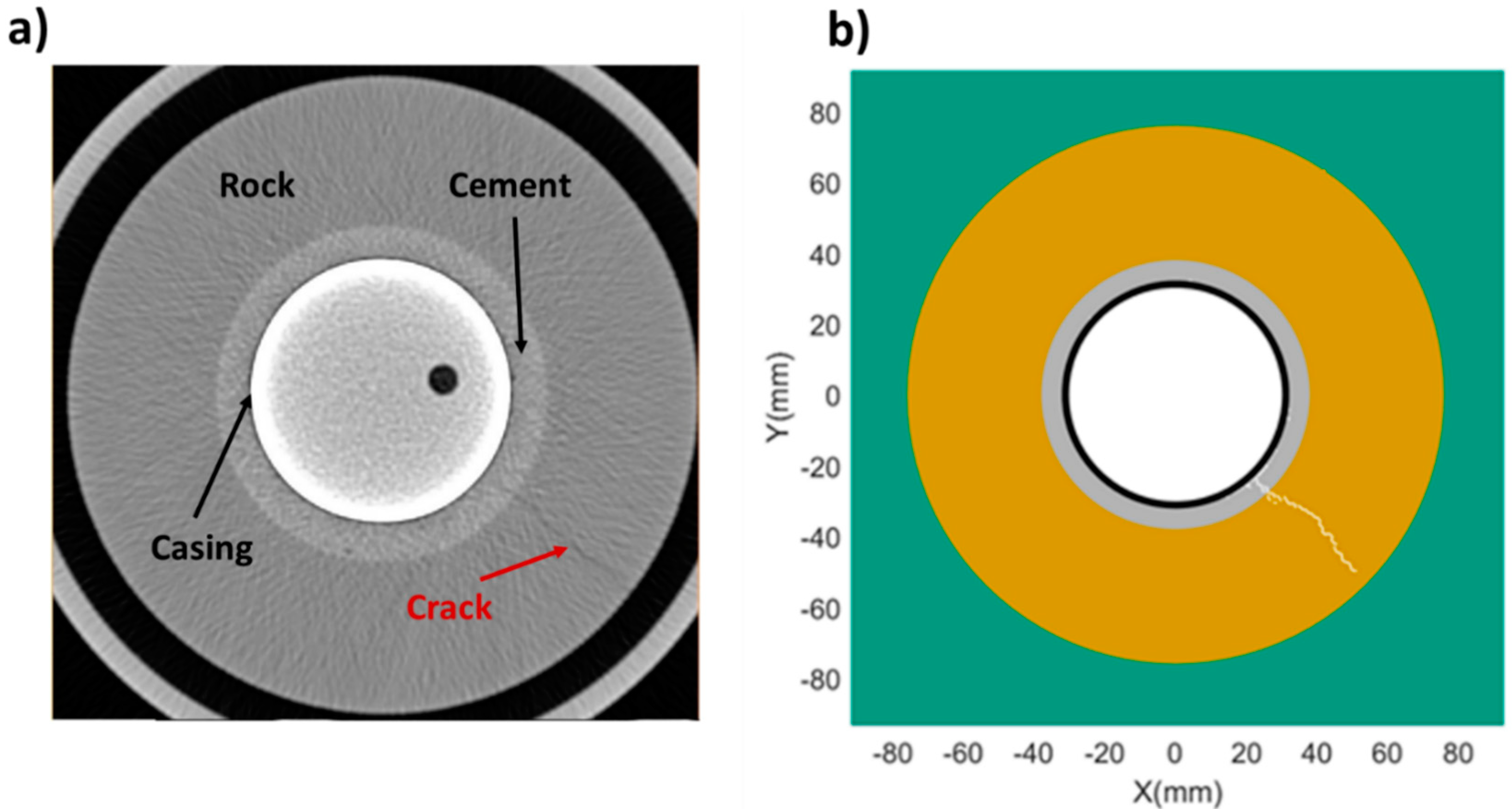
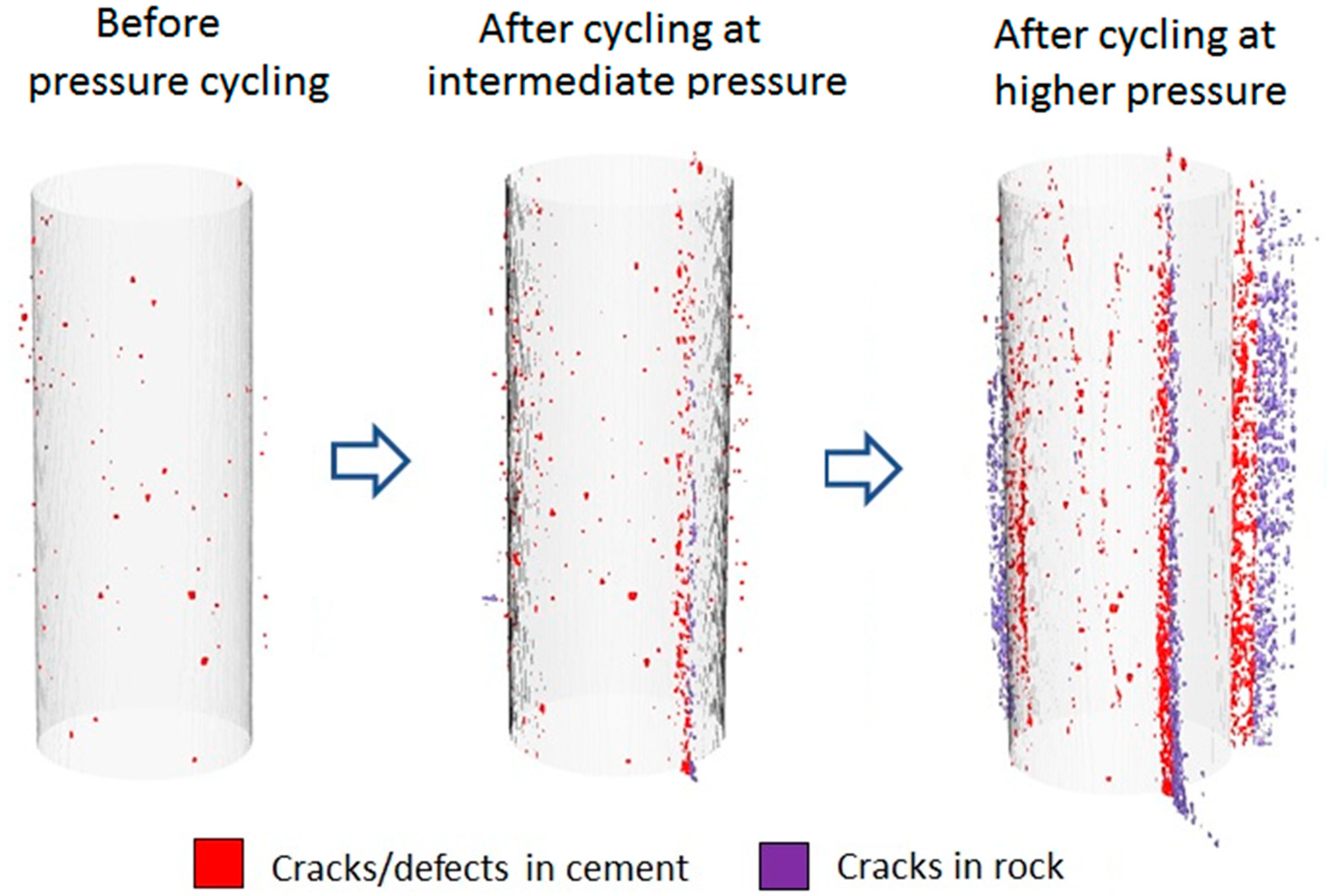
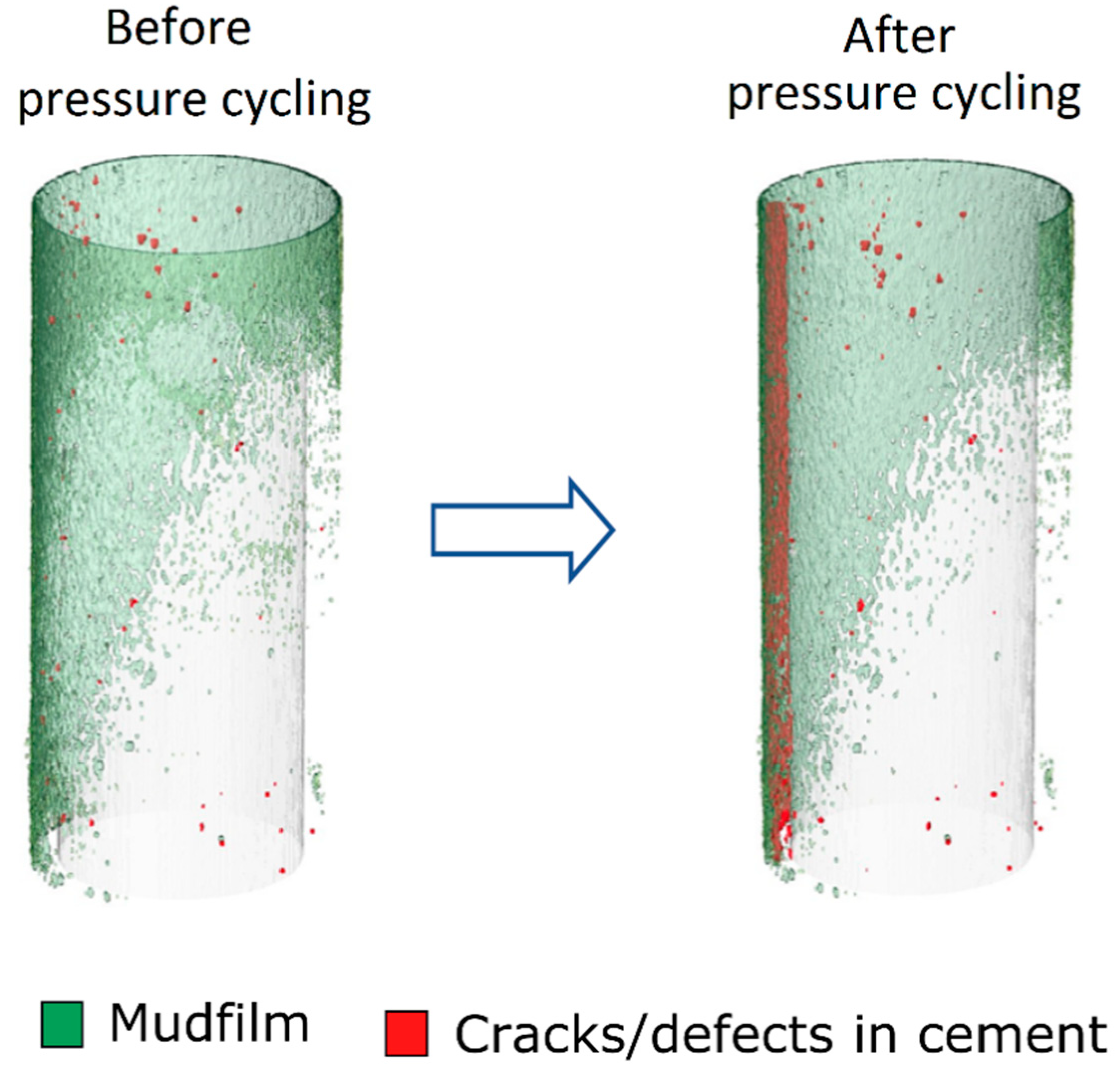
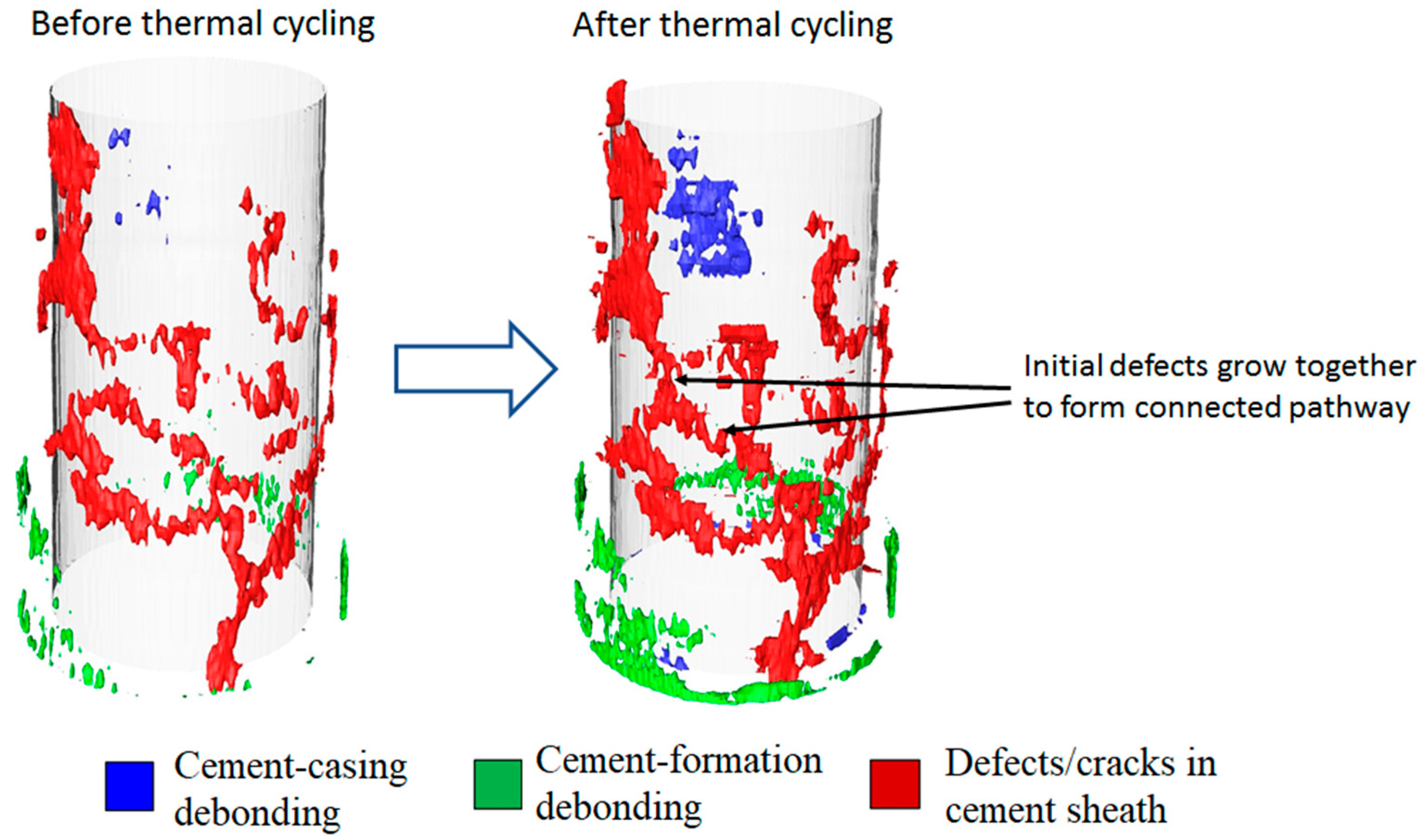
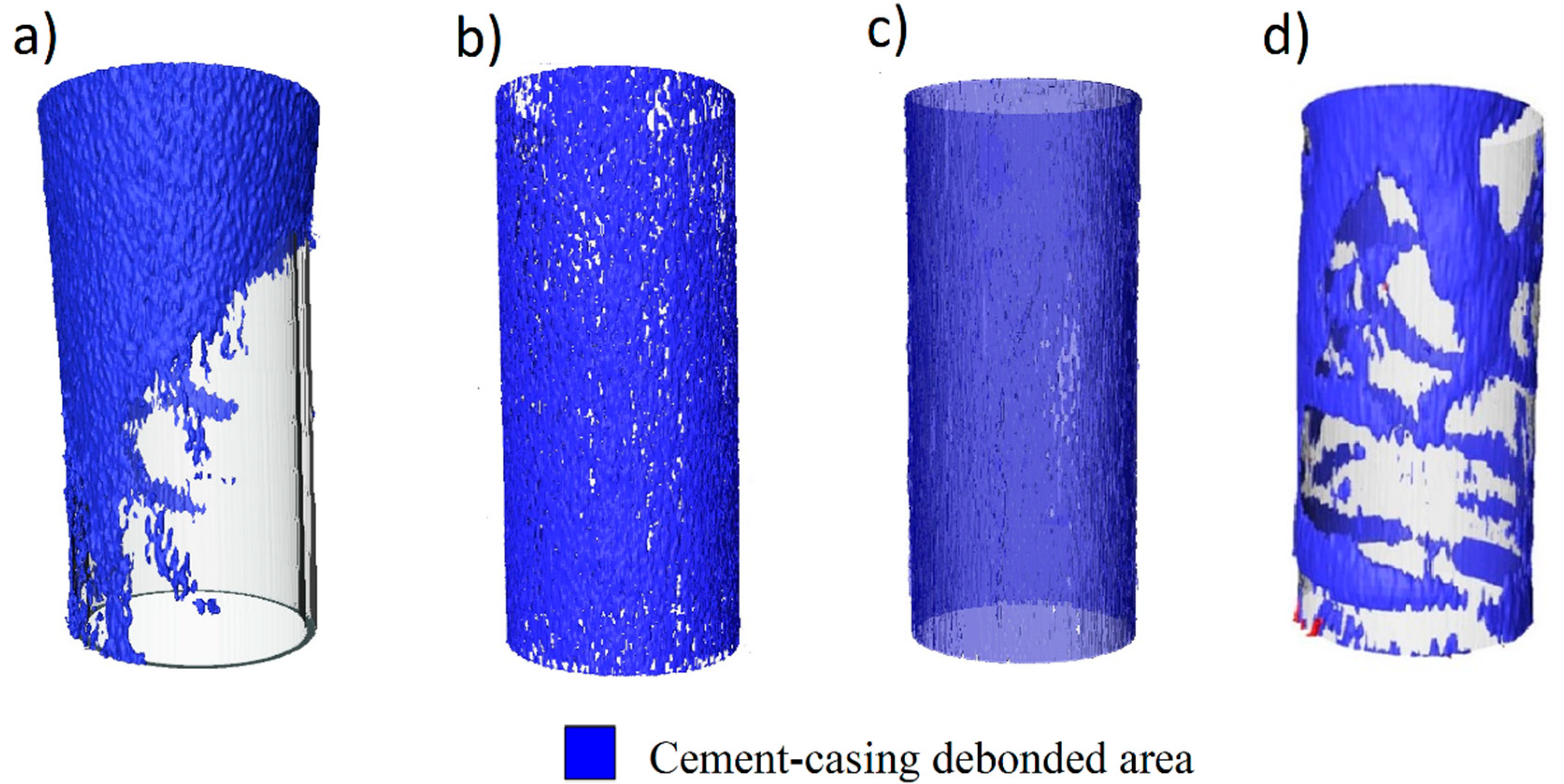
© 2020 by the authors. Licensee MDPI, Basel, Switzerland. This article is an open access article distributed under the terms and conditions of the Creative Commons Attribution (CC BY) license (http://creativecommons.org/licenses/by/4.0/).
Share and Cite
Vrålstad, T.; Skorpa, R. Digital Cement Integrity: A Methodology for 3D Visualization of Cracks and Microannuli in Well Cement. Sustainability 2020, 12, 4128. https://doi.org/10.3390/su12104128
Vrålstad T, Skorpa R. Digital Cement Integrity: A Methodology for 3D Visualization of Cracks and Microannuli in Well Cement. Sustainability. 2020; 12(10):4128. https://doi.org/10.3390/su12104128
Chicago/Turabian StyleVrålstad, Torbjørn, and Ragnhild Skorpa. 2020. "Digital Cement Integrity: A Methodology for 3D Visualization of Cracks and Microannuli in Well Cement" Sustainability 12, no. 10: 4128. https://doi.org/10.3390/su12104128
APA StyleVrålstad, T., & Skorpa, R. (2020). Digital Cement Integrity: A Methodology for 3D Visualization of Cracks and Microannuli in Well Cement. Sustainability, 12(10), 4128. https://doi.org/10.3390/su12104128



